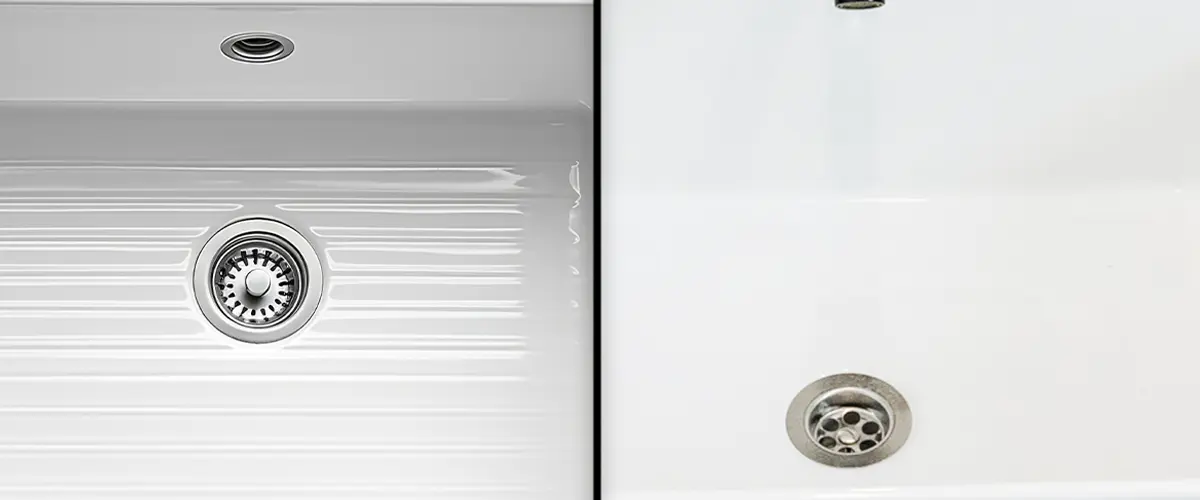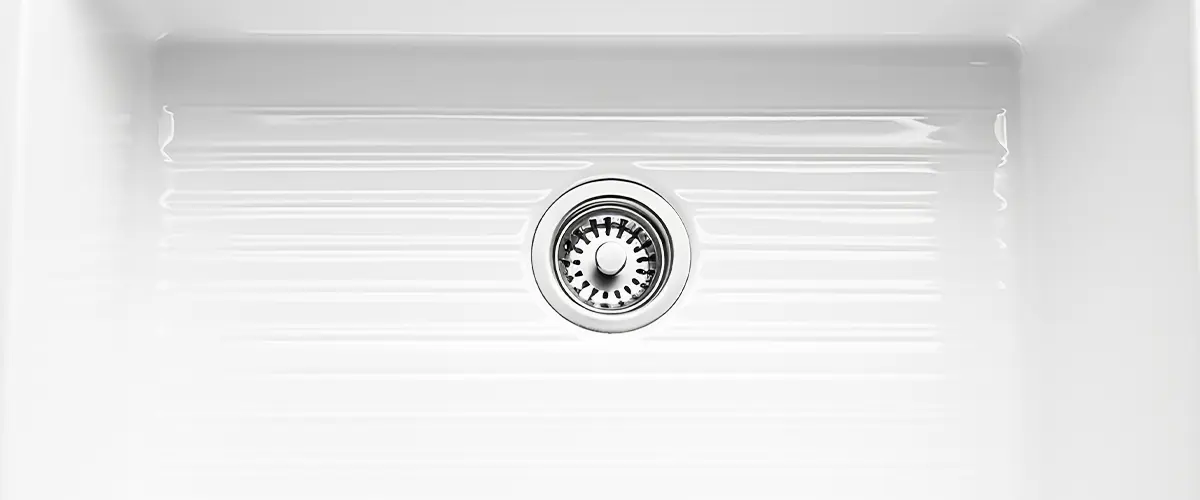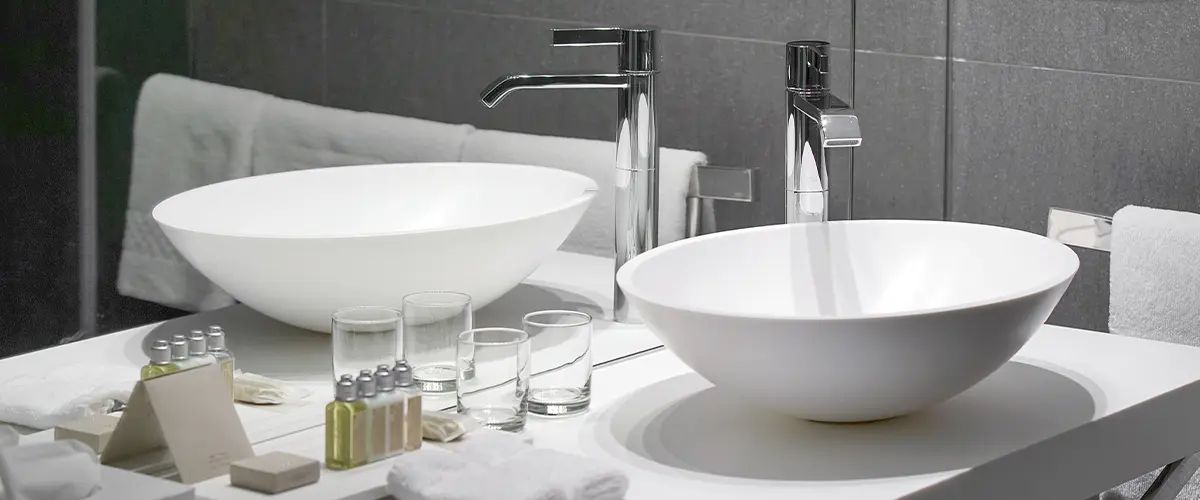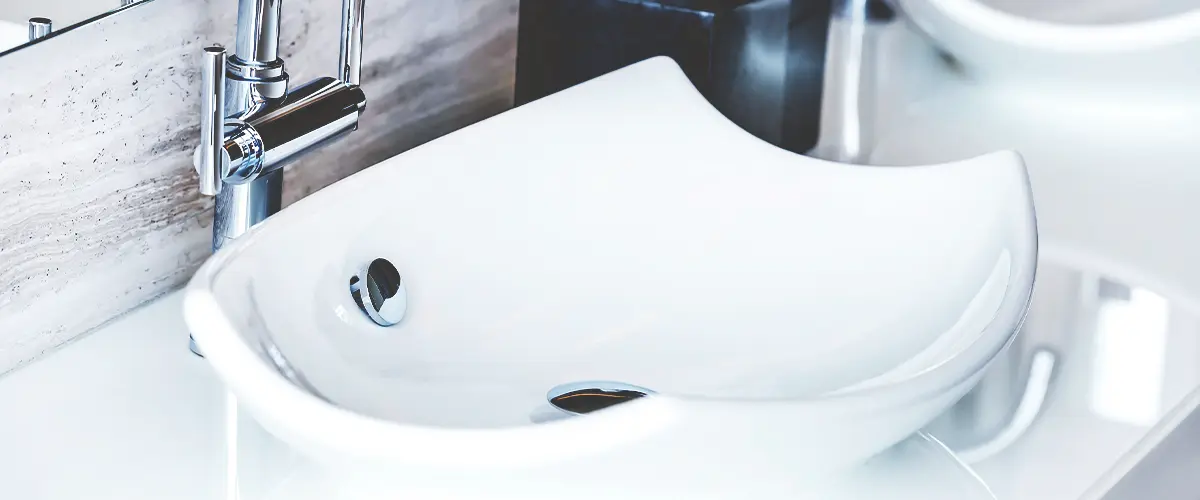Vitreous China Vs Porcelain: Which One Is Better?
Choosing between vitreous china vs porcelain for your bathroom sinks can be confusing. Both materials are popular choices for their durability and glossy finish. This article breaks down the differences, advantages, and considerations of each to help inform your decision.
Discover which is better for your home.

Key Takeaways
- Vitreous china is made from clay, quartz, and feldspar, fired at high temperatures to create a durable and glossy surface. It's great for bathroom fixtures because it resists scratches and stains.
- Porcelain comes from kaolin clay mixed with minerals, fired at even higher temperatures to make it strong and glass-like. This material works well for kitchen sinks and decorative items due to its heat resistance.
- Both vitreous china and porcelain offer excellent durability and stain resistance but have different uses based on their strengths. While vitreous china shines in bathrooms for its maintenance ease, porcelain holds up well in kitchens.
- Keeping these materials looking good requires simple care: use mild cleaners, avoid harsh chemicals, prevent scratches by using soft cleaning tools, clean spills quickly to dodge stains, and consider sealants for extra protection.
- When choosing between vitreous china or porcelain for home fixtures, think about where it will be used: bathrooms benefit from vitreous china’s easy cleaning while kitchens gain from porcelain’s resistance to heat.
What is Vitreous China?
Vitreous china is a type of ceramic material known for its smooth, glass-like surface. It is produced by firing a mixture of clay and other materials at very high temperatures in a kiln.
- History and uses of vitreous china
People have used vitreous china for many years. It started out in the pottery industry centuries ago. This material became popular because it’s strong and looks great. Vitreous china sinks and toilets are common in homes today.
They are made from clay, glass, and quartz that get fired at high temperatures.
This firing process creates a glossy surface that is easy to clean and resistant to scratches and stains. The shiny finish also makes vitreous china sanitary for use in bathrooms and kitchens.
People choose vitreous china for basins, bathtubs, and even kitchen sinks because of its durability.
- Physical properties of vitreous china
Transitioning from its roots, vitreous china is recognized for its impressive physical characteristics. Created through the integration of powdered glass and ceramic clay, this substance faces high-temperature firings.
This procedure results in a remarkably dense and non-porous surface. The constitution of vitreous china endows it with extraordinary resistance to stains and scratches, placing it ahead of many comparative sink materials such as stainless steel or glass sinks.
Vitreous china possesses a prominent gloss shine which not only delivers an elegant appearance but also facilitates its low upkeep attribute. Grime, soap residues, and water marks struggle to adhere to it, thus allowing for easy cleaning using just a cloth and a gentle detergent.
Contrasting the enamel on the cast iron sinks, which may rust over time, vitreous china preserves its shine without discoloration or corrosion. Its resilience guarantees that faucets and fixtures constructed from this substance stay in immaculate condition for routine use, year after year.

- Production process of vitreous china
Crafting vitreous china necessitates following a specific series of steps. This material is recognized for its high-gloss finish and endurance, making it a favored option for numerous homeowners. Here’s the production process:
- Careful selection of raw materials: It begins with the careful selection of raw materials such as clay, quartz, feldspar, and silica. These elements are finely crushed to generate a seamless blend.
- Water is integrated: Water is integrated into the dry blend to produce a slip, a creamy liquid that facilitates item molding.
- Slip is emptied into plaster casts: The slip is emptied into plaster casts that determine the final product’s contour. Extra liquid is drained off, leaving a solid structure behind.
- Structure extracted from the cast: Once the structure has solidified, it is extracted from the cast. This phase is referred to as greenware.
- Greenware undergoes detailed cleaning: The greenware undergoes detailed cleaning and smoothing to eliminate any flaws.
- Initial firing in a kiln: Subsequent is the initial firing in a kiln at roughly 2200°F (1200°C). This phase transforms the greenware into bisque-fired items.
- Glass particle enamel coating: Post cooling, a glass particle enamel coating is applied to all bisque ware surfaces.
- Second firing at higher temperatures: The coated items are then subjected to a second firing at temperatures higher than the initial. This firing melts the enamel, adhering it to the ceramic surface, creating the glossy finish characteristic of vitreous china.
- Thorough inspection for quality: Lastly, each item undergoes a thorough inspection for quality and endurance before being deemed fit for regular use.
This rigorous procedure ensures vitreous china fixtures are easy to maintain and resistant to scratches and stains. Transitioning to the process of porcelain production presents a different yet equally intriguing adventure in ceramic manufacturing.
What is Porcelain?
Porcelain is a type of ceramic material with a high sheen. The production process requires careful inspection and employs glazing techniques to achieve a glassy finish.

- History and uses of porcelain
Porcelain has a rich history dating back to the Tang Dynasty in China around 618-907 AD. Initially prized for its delicate appearance and reserved for the royal families, it has since spread across Asia and into Europe.
Today, porcelain is widely used in household fixtures, known for its durability and resistance to scratches and stains.
The applications of porcelain have expanded to include a wide array of products, such as stainless steel sinks featuring a porcelain enamel coating. This coating not only enhances the visual appeal but also offers lasting protection against harsh cleaners.
Porcelain’s versatility extends to serving as an ideal material for cast iron base support in various fixtures, given its heat resistance and low maintenance needs. As a result, it remains a popular choice for everyday use among homeowners.
- Physical properties of porcelain
Porcelain, a type of ceramic, exhibits exceptional physical properties and is well-known for its durability, high gloss shine, and resistance to scratches and stains. The material undergoes thorough inspection during production to ensure it meets specific shape and quality standards.
Its dense composition gives it a glass-like finish, making it resistant to abrasive cleaners and soap scum. This strength ensures that porcelain sinks and fixtures remain visually appealing even after prolonged use, solidifying its popularity in household fixtures.
The physical properties of porcelain highlight its resilience, enduring the wear and tear of everyday household use. Its sturdy nature allows homeowners to maintain these fixtures without worrying about unsightly blemishes or damage, making it an excellent choice for surfaces subjected to heavy usage, such as countertops or sink basins.
- Production process of porcelain
Porcelain Production Process:
- Porcelain consists of a mixture of kaolin, quartz, and feldspar.
- The materials are mixed and then fired at high temperatures, usually between 1200°C to 1400°C.
- This firing process results in the materials vitrifying, creating a hard, translucent, and non-porous material.
- After cooling, the porcelain undergoes thorough inspection for imperfections before further processing.
- The porcelain is then glazed with a glass-like coating to improve both its appearance and durability.
Keep in mind that the production process ensures that porcelain is durable and resistant to scratches and stains.
Key Differences Between Vitreous China and Porcelain
Vitreous china is made from a mix of clay, feldspar, and quartz, making it stronger and more durable than porcelain. To learn more about how these differences can impact your household fixtures, keep reading!
Between Vitreous China vs Porcelain - Composition
Vitreous china is made from a blend of various materials, including clay, feldspar, and quartz. This composite creates a smooth and glass-like finish that is both durable and resistant to stains and scratches.
Porcelain, on the other hand, comprises a mixture of clay and other minerals such as kaolin. The high temperature at which porcelain is fired results in its dense composition, making it strong yet delicate.
These distinctive compositions contribute to the unique properties of vitreous china and porcelain that make them suitable for different household fixtures like ceramic sinks.
The key difference lies in their compositions – vitreous china combines clay with feldspar and quartz while porcelain consists mainly of kaolin along with other minerals.
Vitreous China vs Porcelain - Strength and durability
Transitioning from the composition, strength and durability of vitreous china plays a crucial role in its appeal for household fixtures. Vitreous china is known for its remarkable strength, with a hardness rating that surpasses even granite.
This inherent sturdiness ensures that vitreous china fixtures are highly resistant to chipping and cracking, making them an ideal choice for high-traffic areas such as bathrooms and kitchens.
Furthermore, the durable nature of vitreous china also contributes to its resistance against scratches and stains, ensuring longevity with minimal maintenance.
Porcelain also boasts impressive strength and durability, making it a popular choice for various household fixtures. Its non-porous nature renders porcelain highly resistant to moisture absorption, reducing the likelihood of cracks due to freezing or thawing cycles in outdoor installations like tiles.
Porcelain’s exceptional durability makes it a reliable option for countertops, sinks, and various decorative elements within homes.
In summary:
- Vitreous China: Exceptional sturdiness exceeding granite hardness; highly resistant to chipping and cracking; minimal maintenance required.
- Porcelain: Non-porous construction reduces risk of cracks due to moisture absorption; ideal choice for diverse household applications including countertops and sinks.
Take into account these strengths when considering between vitreous china and porcelain options!
Resistance to scratches & stains of Vitreous China & Porcelain
Vitreous china is highly resistant to scratches and stains, making it an ideal choice for high-traffic areas in the home. Due to its non-porous surface, vitreous china is less likely to accumulate dirt or grime, allowing for easy cleaning with just a mild detergent and water.
This feature makes it a popular option for bathroom fixtures like sinks and toilets where cleanliness is essential. Porcelain also offers excellent resistance to scratches and stains, making it suitable for similar applications within the home.
When comparing vitreous china vs porcelain in terms of resistance to scratches and stains, homeowners can confidently select either material knowing that both are designed to withstand everyday wear and tear.
Vitreous China vs Porcelain - Which One Is Better?
Which material is better: vitreous china or porcelain? What are the factors to consider when deciding which one is best for your household fixtures?
Factors to consider
When deciding between vitreous china and porcelain for your household fixtures, consider the following factors:
- Composition: Vitreous china is made from a blend of clay, quartz, and feldspar, giving it a glass-like finish. Porcelain, on the other hand, contains kaolin clay and is fired at a higher temperature.
- Strength and durability: Vitreous china is known for its durability and resistance to chipping and scratching, making it an ideal choice for high-traffic areas. Porcelain is also durable but may be more prone to chipping due to its composition.
- Resistance to scratches and stains: Vitreous china’s non-porous surface makes it highly resistant to stains and easy to clean. Porcelain’s porous nature may make it more susceptible to staining over time.
- Popular uses in household fixtures: Vitreous china is commonly used for toilets, sinks, and bathroom fixtures due to its resilience. Porcelain is often used for decorative items such as dinnerware and decorative tiles.
- Maintenance and care tips: Both materials are relatively low maintenance; however, regular cleaning with mild soap and water is recommended to preserve their appearance.
Consider these aspects before selecting vitreous china or porcelain for your household fixtures.
Popular uses in household fixtures
Vitreous china is frequently used in bathroom fixtures such as toilets, sinks, and urinals due to its durability and water resistance. Its smooth, glass-like surface makes it easy to clean, making it a popular choice for busy households.
Porcelain, on the other hand, is commonly found in kitchen sinks and countertops because of its resistance to heat, making it ideal for cooking and food preparation areas.
These materials are embraced by homeowners for their practicality and aesthetic appeal. The use of vitreous china or porcelain in household fixtures can significantly elevate the functionality and visual appeal of kitchens and bathrooms while providing long-lasting performance.
Now let’s explore maintenance and care tips for these materials.
Maintenance and care tips
After understanding the popular uses of vitreous china and porcelain in household fixtures, it is important to know how to properly maintain and care for these materials. Here are some simple yet effective maintenance and care tips for homeowners:
- Cleaning: Use mild, non-abrasive cleaners to avoid damaging the surface. Rinse thoroughly after cleaning to prevent residue buildup.
- Avoid Harsh Chemicals: Refrain from using harsh chemicals such as bleach or ammonia, as they can cause discoloration or damage.
- Prevent Scratches: Use soft-bristled brushes or sponges when cleaning to avoid scratching the surface. Avoid abrasive materials like steel wool.
- Stain Prevention: Quickly clean up any spills to prevent staining. Consider applying a protective sealant to enhance stain resistance.
- Regular Maintenance: Clean regularly to prevent dirt and grime buildup over time. Inspect for any cracks or chips and address them promptly.
- Care for Fixtures: Handle vitreous china and porcelain fixtures with care to prevent accidental damage. Avoid dropping heavy objects on the surfaces.
By following these maintenance and care tips, homeowners can ensure that their vitreous china and porcelain fixtures remain in top condition for years to come.

Also read about: Apron Sink Vs Farmhouse Sink
Top Manufacturers of Vitreous China and Porcelain Products
When selecting vitreous china or porcelain for household fixtures, choosing reputable manufacturers is crucial for quality and durability.
- American Standard: A long-standing leader in bathroom fixtures, known for innovative designs and exceptional reliability.
- Kohler: Renowned for craftsmanship and elegant designs, Kohler’s products blend style with high functionality in bathrooms and kitchens.
- TOTO: A pioneer in high-efficiency toilets, TOTO focuses on sustainable technology without compromising comfort and aesthetics.
- Gerber: Offers durable and stylish vitreous china products, known for their easy maintenance and affordable pricing.
- Porcelanosa: Specializes in high-quality porcelain tiles and sanitary ware, combining aesthetic appeal with innovative technology in design.
FAQs
Vitreous china and porcelain are types of ceramics with a glass-like finish that are meticulously inspected for quality.
The choice between vitreous china and porcelain depends on various factors such as durability, maintenance, and the aesthetic you’re aiming for.
The vast majority of ceramics available in the market can be either made from vitreous china or porcelain.
Both vitreous china and porcelain undergo meticulous inspections to ensure their glass-like finishes meet high-quality standards.
Trust Our Experienced Team
Our team has been delivering top-notch service for years, embodying professionalism and expertise. Choosing the best ensures you save money in the long run. If you live in California and you’re ready to tackle your bathroom remodeling project with our industry experts, contact us at (626) 598-0833 to get started.
